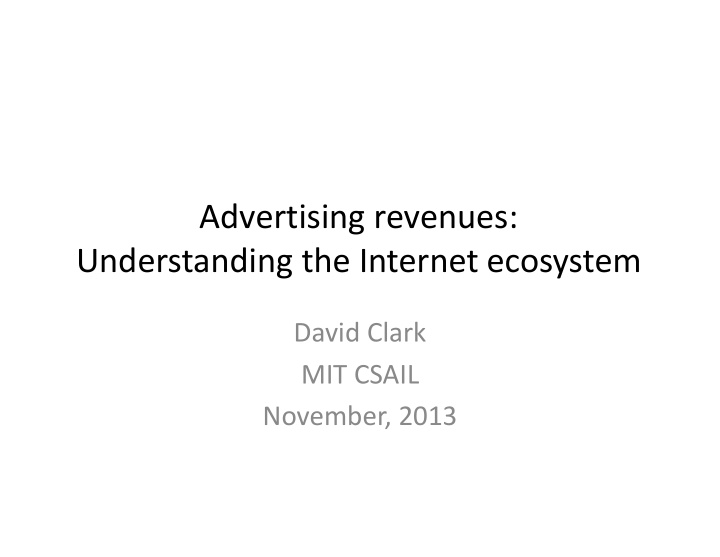



Advertising revenues: Understanding the Internet ecosystem David Clark MIT CSAIL November, 2013
Ad revenue data • From Interactive Advertising Bureau (IAB) unless otherwise noted. • Data gathering and analysis: Israel Valentin Vinagrero. (Grad student at MIT ‐‐ thank you.) – Also doing some industry interviews. • US interactive ad spend 2012: $36.6B. – Per HH: $34.63/month
A lot or a little? • Am I really worth that much? • This pays for all of the “free” Internet experience. – All the web sites based on ads and behavioral profiling. – From this point of view, it seems like a little.
Online advertising per BB household (2012) 4
Total consumption and online adv/total ratio 5
Explanation? • Consumer wealth is not the (only) explanation. • Perhaps it is privacy policies? – Hypothesis from Catherine Tucker, MIT Sloan. – One estimate is that removing behavioral tracking information cuts the value of an ad by 75%. • Gill et al. , Follow the money: Understanding Economics of Online Aggregators and Advertising , IMC 13 • The value of tracking is critical going forward. – Who knows the mobile user? – What happens to TV ad revenues? – Who might the consumer trust?
Internet expenditures per BB household Total excluding CDN and advertising: $479.47 ($82,74 per paying customer) 7
eCommerce: Top 5 countries by B2C Sales
Ecommerce and online ad per BB HH
Online ad per country evolution – S shape
Revenues • A recurring conversation centers on the sources of revenues for ISPs. – Today the consumer pays essentially all the costs of the access provider. • Is there an alternative frame in which other parts of the ecosystem contribute to the cost of access? – Advertising? – Paid content?
In the press… Financial Times April 9, 2010 Google accused of YouTube ‘free ride’ By Andrew Parker in London and Richard Waters in San Francisco Some of Europe’s leading telecoms groups are squaring up for a fight with Google over what they claim is the free ride enjoyed by the technology company’s YouTube video ‐ sharing service. Telefónica, France Telecom and Deutsche Telekom all said Google should start paying them for carrying bandwidth ‐ hungry content such as YouTube video over their networks. http://www.ft.com/cms/s/2/8f5d6128 ‐ 4400 ‐ 11df ‐ 9235 ‐ • 00144feab49a.html#ixzz2l92zeRnM
Speculate about Italy • Per ‐ household ad spend: $11.57/month. • Speculate that Google is 41% ‐ > $4.75 • What could an access ISP manage to extract as a share? 5% of top line? ‐ >$.23/month. • Now think about the developing world.
Health of the ecosystem • All of the “free Internet experience” is being sustained by ad revenues. • Where do they go?
Google • The x00 pound gorilla in advertising. • Revenues (worldwide 2012): – Google sites: $31,211 – Ad partners sites: $12,465 • Partner share: $10,956 – Net Google: $1,509 – Total Net: $32,720 – US share: 46% $15,051 41% of total
Mobile ad Situation • Before a standard solution is accepted, Facebook is already bringing advertisers on board with its tracking solutions: 16
A lesson here about ads • If an ISP tries to extract value from Google, by charging by the byte, • And Facebook gets good at ads, • Since Facebook does not deliver video (traffic volumes are minimal), • ISP gets no value from Facebook. • But a direct partnership with Facebook (like 0.facebook.com) is a great deal. – Don’t think “enemy”, think “strategic partner”.
Recommend
More recommend